This is the route that we took - sort of. The line shows the quickest way from point to point via motorway but we went much of the way on the country roads. This shows the general 936km (581miles) tour that we took in the last week of June. The following shows the main points of interest that we headed to.
The whole trip started out with a 25 year anniversary gift from our good friends John and Birthe. If you have been following this blog, then you have a good idea of who they are. We got a gift certificate from them for a night at a charming country inn. There was a selection of inns to choose from and we decided on an inn in a little 'middle of nowhere' village that was somewhere along the way to northern Germany. I chose Menstrup Kro basically because of the Guard Hussar Regiment exhibition at the hotel. The Guard Hussar dates all the way back to 1762. It is a special cavalry unit of the royal army and it's main function is to place mounted escorts and commando forces at the service of the royal family, and to train them for various functions in the mobilization force. The mounted squadron's history, traditions and uniforms can be traced back in a direct line to the Hussar Regiment set up by King Frederik V in 1762. Originally it was set up to have a mobile cavalry to face the Cossacks in the impending war with Russia. The Guard Hussar had their base in Næstved which is near Menstrup. When we got to the inn, we learned that the Guard Hussar had been moved to another city - Slagelse.
here is the link to Menstrup Kro. click on the first pix on booking.com to see the other pix. The pictures are wayyyyyy more shiny than what it really is: worn down shit with historic charm. I hated it and loved it at the same time. The food was good and was included in the gift cirtificat - both dinner and breakfast. You can see the other pix on my shutterfly page.
here is the facebook link to Guarde Hussar if you want up to date info.
Though the guardsmen have moved onto Slagelse, once we had checked into the inn, we drove into Næstved anyway to see the town. I loved and wanted to see more of it but we were already behind schedule and this was only the first day. Luckily I live only a short car/train ride away. Here are 5 pix from Næstved and you can see the others on my shutterfly page.
But before we drove to Næstved, Jens wanted to see a painting of the queen at Herlufsholm. Unfortunately today is Monday so the place was closed. We could only see the outside of the area as well as the inside of the church. Herlufsholm was founded in 1565 as a boarding school for "sons of noble and other honest men."
Click the link to learn more about Herlufsholm.
Here are 5 pix from Herlufsholm.
Click this link to see the other pix on my shutterfly page.
DAY 2
Today's plans are to check out 3 small Danish towns and then cross the border by ferry to north Germany. Our hotel is lakeside in the forest near a town called Eutin.
VORDINGBORG - a small town with a huge, long history. Today we are here to see the castle that King Valdemar the Great built in 1157. The king wanted a gathering place for his navy for defense and attack. He kept his ships in the harbor below the castle and they were ready for attack at moments notice. Vordingborg city appeared in the beginning of the 1100's but first became meaningful with the emergence of the castle. Valdemar went to war with the local tribes together with Bishop Absalon, and in 1169 the Danish army landed on Rügen, Sweden and conquered the castle of Arkona. Valdemar returned victoriously home to Vordingborg, where he died in 1182.
Valdemar the Victorious (a different Valdemar) was often in residens at the castle and used it frequently for the Royal Danish Court. In 1241 he confirmed Jyske Law as a national law applicable to the entire Kingdom of Denmark. This is very important for Denmark as this is the beginning of events that lead to the present day Danish constitution.
Valdemar Atterdag ( a 3rd Valdemar) in the 1360's enlarged the castle grounds with 9 towers. He topped this tower with a golden goose to mock the Hanseatic cities (northern parts of Germany, Poland and the Baltic countries). He pissed off a lot of European leaders and received numerous threats.
On the castle grounds, there was a new Viking exhibition - way cool and I'm going back to see it in detail. Here are 5 pix from Vordingborg.
You can see the others on my shutterfly page.
SAKSKØBING - at the end of a fjord, Sakskøbing was an important town for trade in the middle ages. By the 17th century, the town was in decline due to the Swedish wars, robbery and fires. The 19th century was, with the exception of a fire in the autumn of 1800, a prosperous period for Sakskøbing, as many new buildings shot up in the urban environment. The port was re-used in 1804, a smaller shipyard came in 1829 and the population rose from 549 in 1801 to a few 100 more over the next few years. The town has basically had it's share of problems with highs and lows. The latest is the closing of the sugar factory. Struggling already in the early 70's and finally closed in 91'.
Here are a few pix from Sakskøbing and you can see the others on my shutterfly page.
 MARIBO - Another important trading town in the middle ages, the city is one of the few Danish market towns located in the country without direct sailing possibilities. Probably the most important fact of the town is about the abbey. Saint Birgitta, also known as Birgitta of Vadstena, has cast her shadow over the town in the mid 1300's, and is shown on the municipality's coat-of-arms. That seems highly usual to me considering women were of less importance than men at the time. I found this pix of the coat of arms on the net. Bridgettine Order's cloister in Maribo, when in 1416, monks from Vadstena cloister were sent to Maribo to help establish a cloister.
MARIBO - Another important trading town in the middle ages, the city is one of the few Danish market towns located in the country without direct sailing possibilities. Probably the most important fact of the town is about the abbey. Saint Birgitta, also known as Birgitta of Vadstena, has cast her shadow over the town in the mid 1300's, and is shown on the municipality's coat-of-arms. That seems highly usual to me considering women were of less importance than men at the time. I found this pix of the coat of arms on the net. Bridgettine Order's cloister in Maribo, when in 1416, monks from Vadstena cloister were sent to Maribo to help establish a cloister.
The history of course goes on forever and is quite interesting - if you are into old religious historic stuff. Wikipeadia it for more info if you have the interest and the time. Otherwise, here are a few pix from Maribo and you can see the other on my shutterfly site.
Ha Ha - jokes on me (and you). I wheeled Jens and his sore, sorry ass on cobble stone streets all the way to the church and didn't even take a pix. So shoot me for only having 450 photos and not a single shot of the church. You'll have to suffice with this copy from the net. - and yes, it was this nice.
Now we have come to the end of the road in the ferry town, Rødby. Soon we'll be in Puttgarden, Germany. I reserved a space on the ferry on the route that is famously known as the Rødby - Puttgarden line. I handed my printed reservation to the fat man in the window and he told us to get into lane 7. That's Jens' lucky number by the way.
We are at a roadside rest stop checking out the map on the board just beyond Jens and I am trying to get my google maps to work on my phone. We should have made an exit from the motorway
2 assfarts ago.
OK - we see that we can get there from here by taking the next Assfart. Going forward is shorter than going back. It's usually that way with all things in life. Finally we see the signs pointing the way to Eutin. Our hotel is just a few minutes drive beyond the town. We plan to check-in first. Take a relaxer and a breather and then head back to Eutin to stroll the steets. But Jens is dead tired so our break turned out to be a longer, needed nap. This meant a late dinner since the hotel restaurant would not serve us. It seems the dinning room was reserved only for the bus load of widows who arrived on the purple Disney Tragic bus. Apparently Jens and I have too much Tinker-Bell within us to compete with Disney.
Parked just out side of our window, that damn purple Disney Tragic bus totally ruined the "funk-shway" of the beautiful forest.
Here is the link to our hotel called: Hotel SeeSchloss am Kellersee. Click this link and then click onto "Das Hotel" to see pix on the German website. The hotel is in the forest between the towns of Eutin and Malente. These 2 towns were never part of our original destination locations for this automobile/trump wall tour. We were supposed to have gone directly from the ferry to Kiel. But our good friend Jørn who knows lots about Germany suggested to us, just days before our departure date, that we drop boring, ugly Kiel and instead head out to Eutin and Malente. The reason being: they are both cute, quaint and are towns with Danish history to them. This was after all, a part of Denmark as far back as the 19th century and ruled by the House of Oldenburg.
This is what Wikipedia says about the House of Oldenburg and I find this to be very exciting. So sorry if you are yawning and don't get it.
House of Oldenburg is a European royal house of North German origin. It is one of Europe's most influential royal houses with branches that rule or have ruled in Denmark, Iceland, Greece, Norway, Russia, Sweden, Schleswig, Holstein, and Oldenburg. The current Queen of Denmark, the King of Norway and the former King of Greece, as well as the consorts of Greece and the United Kingdom and the first seventeen names in the line of succession to the British throne, all belong to this house.
It rose to prominence when Count Christian I of Oldenburg was elected King of Denmark in 1448, of Norway in 1450 and of Sweden in 1457. The house has occupied the Danish throne ever since.
When we did finally get up from dreamland and go to dinner in Eutin, it was late. We are supposed to see the town of Eutin today or our travel plans will be forever very far behind. But we never even made it to a restaurant until 8 in the evening and where in the world will we ever find time to see Malente?
DAY 3
This is a vacation so we are allowed to take it easy and be delayed - right? And enjoy our breakfast is exactly what we did.
From the castle we head into the city center to get a quick glimpse of the town and St. Michael's Church. It is the 500 year anniversary of Martin Luther. I was surprised to see that there was no mention of him at all at this Evangelical Lutheran church. It was 500 years ago that Luther reformed the church - thus the name of the time: The Reformation Period. Hans Tausen went to Germany in 1523 where he met with Martin Luther and studied his teachings. 1½ years later Tausen was called back to Denmark and he brought with him the ideas of Luther and spread them throughout the country.
Now we are packed and ready to find some Donald Trump inspiration. We didn't have time to see Malente. We barely had time to see Eutin. But I thought we could at least drive through Malente so I could snap a few pix from the car window. But wouldn't you know it, we got lost - again. After Malente, my plan was to take a casual drive, nice and easily on the country roads through Pöln. I don't exactly know where we were or how we got there but we were way lost and we didn't have the time to be fooling around. We actually ended up on a pedestrian street and people would not move out of my way - rude! I made a quick left and we end up on a very steep hill going down -almost falling, and I suddenly felt like Chevy Chase in European Vacation. This is me at the 00.10 second mark and my sentiments at the 3.27 mark.
Danevirke - the viking wall
Inspiration for Trump
This is the main point of our tour. It is the highlight destination and the entire reason for this travel. It was to see some very exciting history and part of the history of this wall is what I had to learn about to receive my Danish citizenship. (still waiting for my passport) This part of my tour was so exciting for me. To be able to see and touch something that I have read and studied about. Last year a television movie was made about the battle of 1864. It became a point of feeling somewhat Danish for me.
The following is paraphrased from Wikipedia and I must say, it has more geographical info than what I had to lean about: Dannevirke, literally meaning 'earthwork of the Danes, is a system of Danish fortifications in Schleswig-Holstein, Germany. That's the part of Germany that we are driving through and formally it was Denmark. This important linear defensive earthwork across the neck of the Cimbrian peninsulas (or - the long stretch of land connecting the mainland of DK with DE) was initiated by the Danes in the Nordic Iron Age at some point before 500 AD. It was later expanded multiple times during Denmark's Viking Age. The Danevirke was last used for military purposes in 1864 during the Second War of Schleswig.
The Danevirke consists of several walls, trenches and the Schlei Barrier - whatever that is. I am assuming it is part of the natural formation line in the earth. The wall stretches for 30 km / 19 miles, from the former Viking trade centre of Hedeby near Schleswig on the Baltic Sea in the east to the extensive marshlands in the west of the peninsula. One of the walls named Østvolden (East Ramparts), between the Schlei and Eckern fjord inlets, defended the Schwansen peninsula.
It was 5m / 16'5" high and 20m / 65' wide and in places topped with a wooden palisade and fronted by a U-shaped ditch. The only way through was along a track known as the army Road, which passed through a gateway in the wall near Hedeby. Despite the Vikings' best efforts to stop an attack, King Harald Bluetooth's men (and yes your cell phones' blue tooth function is named after this king) were overcome by Saxon warriors in 974 and the Danevirke and border region around it occupied. In 983, the wall was retaken by the Danes with the aid of warriors stationed at Denmarks nearby circular fortresses called Vikingeborg.
According to written sources, work on the Danevirke was started by the Danish King Gudfred in 808. Fearing an invasion by the Franks, who had conquered heathen Frisia over the previous 100 years and Old Saxony in 772 to 804, Godfred began work on an enormous structure to defend his realm, separating the Jutland peninsula - which is the mainland of DK from the northern extent of the Frankish empire. The Danes however, were also in conflict with the Saxibs south of Hedeby during the Nordic Iron Age and recent archaeological excavations have revealed that the Danevirke was initiated much earlier than King Gudfred's reign, around 500 AD and probably well before that even.
So basically - at one point in history, Denmark stretched all the way south as far as this defense wall. A number of battles were lost and won here. Before Germany was a country, it was a land of many empires and probably with fighting amongst themselves. But it was Otto von Bismarck of Austria who put the country of Germany together and led the battle against the Danes in 1864. With this battle, the Danes lost a huge chunk of land.
Over the years the border between Germany and Denmark has shifted several times. The latest shift was in 1920 and without a war. It shifted by a vote. All the people in the area voted where the line should be and many of the "Germans" wanted to unite back to Denmark.
The 2 countries on either side of the wall have never had better relations with each other than they do now. So this wall only goes to show that war is unnecessary. This shows that walls are useless. And it shows you can better solve problems with diplomatic solutions. And still - the Mexicans haven't paid one single peso.
This would be a good place to let people know that they should not climb up upon the wall.
I felt so badly after taking this photo. I asked Jens if he thought it was ok for me to get up on the wall so I could have my pix taken. He said of course. There were no signs to keep off. But it was only after I came down and we continued along the wall that we came upon a sign that said to please keep off the wall. I couldn't believe that the sign was after the wall and not before coming to the wall. I reported my poor behavior to the woman who sold us the ticket to the museum and suggested that they move the sign to the beginning of the wall and not after the wall. She said that she will take note of that.
Why, yes of course you can see the other photos on my shutterfly page.
Next Stop - Hedeby
Hedeby was an important Viking Age (8th to the 11th centuries) trading settlement near the southern end of the Jutland Peninsula. Jutland, in case you haven't been paying attention, is the mainland of Denmark. 406 island, you know ?! Hedeby was in Denmark but now it's in Germany. It is the most important archaeological site in Schleswig-Holstein. That would be north Germany. And if it is the most important archaeological site, then why have I been wasting time at the wall. But that's the point - isn't it? The wall is a waste of time.
The settlement developed as a trading centre at the head of a narrow, navigable inlet which connects to the Baltic Sea - which eventually leads you to anywhere around the world. The location was favorable because it was a convenient place where goods and ships could be ported overland for an almost uninterrupted seaway between the Baltic and the North Sea and avoid a dangerous and time-consuming circumnavigation of Jutland, providing Hedeby with a role similar to Lübeck. Hedeby was the second largest Nordic town during the Viking Age, after Uppåkra in present-day southern Sweden. The city of Schleswig was later founded on the other side of the Schlei. Hedeby was abandoned after its destruction in 1066.
Hedeby was rediscovered in the late 19th century and excavations began in 1900. The Viking Museum was opened next to the site in 1985. I will have to try and catch that next year. For now, we had to get some grub in our stomach at a restaurant called Odin. Odin as you know, is the king of the viking gods..
Here are 2 pix from our hotel in Schleswig and you know where to click to find the other pix.
Before we left Copenhagen, the weather man promised 2 months worth of rain in less than 1 week. That week would be the week that we were traveling. We were pretty lucky that it stayed dry most of the time. However, after we checked-in, the sky became very dark, so I only took one pix and decided to wait for the following day to take more photos when there was more light.
The whole time that we have been on the road, Jens and I kept saying to each other: Where are my glasses? Have you seen my glasses? We took 11 pairs of glasses with us and we couldn't find them. How many sets of glasses do you see here? There are 11 sets. If you only can count 10 or less, then you need glasses. Really - how many do you see?
DAY 4
Schleswig
The history is too long and too in-depth to make a sentence or two of it. But that is exactly what I will do and say, that Schleswig was a major port and trade center in the Viking Age. It's still an important city. Much of the population here speaks Danish even though it is now Germany. There are schools that teach in Danish. There is also a Viking Museum at Schleswig Castle aka Gottorf Castle. The castle is large and most tourist go to visit it. However, just a few steps off side of the castle is a non descript box. Looks kind of like a annex building for storage but it's the viking ship museum. This was our point of destination and why we came here - to see the viking ship museum and not the Gottorf Castle like most of the other tourist.
on day 4.....
We woke up this morning in total shock. There came so much rain last night and wind blowing water inland from the fjord that the area was completely flooded. Check out the picture above and you can see behind Jens that there is a body of water, a dock leading to the sail boats, a gate (looks like it is fan shaped behind Jens's neck), a strip of grass, a bike trail, another strip of grass, a gate to the hotel garden (you can see just a bit of it in front of his chest), and then the garden of the hotel. Now look at what we woke up to:
No dock, no strips of grass, no bike trail. Notice there is just water and 2 gates.
Anyway... we loved the hotel. It looked like the kind of place where Doris Day and Rock Hudson could spend a pretend, romantic evening on a silver screen in the 60's. It could be a great place for Jens and I to have a pretend, romantic, long weekend - in sunny weather.
But alas - it was time to stop pretending, pack up, eat breakfast, check out and go see what we came to see: The Viking Ship. But first we had a few sites on the list to go through before we get to the Viking ship.
First stop: Schleswig Cathedral
First stop: Schleswig Cathedral
Huge, beautiful and fascinating. Schleswig Cathedral, officially named 'Cathedral of St. Peter at Schleswig', is the main church of the city and was the cathedral of the Bishop of Schleswig until the diocese was dissolved in 1624. It is now a church of the North Elbian Evangelical Lutheran Church, the seat of one of its bishops, and ranks among the most important architectural monuments of Schleswig-Holstein. In other words: once a catholic cathedral, now a Lutheran church. It's a spooky place as it is said that Danish King Niels' spirit haunts the church. King Fredrick I is also entombed here at the cathedral.
From the Cathedral we did a quick drive though a recommend area from our friend Jørn. He pointed it out to me on the map. But when it came time to driving to the area that I thought he pointed out, I knew we were lost. We gave up and drove back towards the castle. But then I saw something and made a quick left. Oh my gosh - it was too cute and I knew we had found the place that Jørn was talking about. It looked a lot like Disneyland.
We didn't have time to get out the car so I just snapped these photos while driving. We had to get to the viking ship museum at Gottorp Castle before the day was gone.
Here now are a few pix from the viking ship museum.......
Both the island where Gottorp Castle sits and the structure itself, were extended through the years, and particularly during the 16th century. Frederick I, younger son of Christian I, made it his primary residence. In 1544 the duchies of Schleswig and Holstein were divided in three parts; Frederick's third son Adolf received one of these parts and made his residence at Gottorp. This state became known as the Duchy of Schleswig-Holstein-Gotorp (that just means: of the specific area. Like Queen Edward of West Covina)
The estate became a European cultural centre in the reign of Frederick III, Duke of Holstein-Gottorp, (1597–1659).
And then bla bla bla bla. This person and that person. Dilapidation. Restoration. Tourism. Ka-ching. $. £. €. And google it yourself for more info. Further below are a few pix of a real viking ship found near by in the mud and restored as much as possible. It was a small museum but you could spend about a week there reading and learning about what they had to tell about just on this one ship alone and the area where it was found - but we only had about 20 minutes and then it was time to move on.
Here now are a few pix from the viking ship museum.......
....and from Gorttorp Castle.
This is the inner courtyard of the castle.
Don't forget to see the other pix on my shutterfly site. Do I sound like an advertiser trying to sell you something? There's nothing to buy. I'm just trying to steal your time.
From Schleswig we had to continue to make our way north to Denmark. Next stop is the border town, Flensburg, still on the German side of the border. It's been great having this booking.com app in my phone. None of our hotels have been planned in advanced with exception of the Menstrup Kro gift certificate. I just open up the app and pick a hotel in the area, click 'book' and presto! we got a room.
Now we have arrived in Flensburg and we are staying at a hotel on the town hall square called Hotel Town Hall - but in German of course. It's on the south end of the pedestrian street with easy access to the main part of the city and easy hotel parking. We are not here to see anything in particular. It's just a main city that we arrived at towards the end of the day. We have just enough time to do a walk up the pedestrian street, grab some dinner, and then walk back along the fjord. Here are a few pix of the area nearby our hotel.
We did a quick stop at St. Nicolas church on the pedestrian street.
Standing at Flensborg Fjord looking towards St. Jürgen.
Our hotel and a link to their web site.
Flensburg was founded at the latest by 1200 at the innermost end of the fjord by Danish settlers which were soon joined by German merchants. In 1284, its town rights were confirmed and the town quickly rose to become one of the most important in the Duchy of Schleswig (or - in the local area). Unlike Holstein, however, Schleswig did not belong to the German Holy Roman Empire. Therefore, Flensburg was not a member of the Hanseatic League (a commercial and defensive confederation of merchant guilds and their market towns), but it did maintain contacts with this important trading network.
Day 5
Breakfast is on the top floor with a view over the town hall square and the surrounding area.
Nothing special but I just liked the designe of this brown and green brick building and the way they were joined together.
We ate, checked out, and then make our way to Denmark. It's raining and this puts a dampener on our plans. It bummed me out. But there was a positive side to it. And that little part of the story comes a little later.
Our plan for today is to drive up along the fjord to see Sønderborg Castle and then see the Royal Palace garden in the town of Gråsten.
But the rain was coming down pretty hard so we skipped the castle and ended up in a coffee shop instead. Kind of a major let down: plans to see a historic castle was canceled so that we could do cake and coffee? WTF? The positive side of it was that it turned out to be a really cool coffee shop and we were dry - for the most part. Here's the link to their facebook page.
From the coffee shop, we drove to Gråsten Palace. To get there from here, we had to cross this draw bridge which just happened to be going up as we were crossing.
From the coffee shop, we drove to Gråsten Palace. To get there from here, we had to cross this draw bridge which just happened to be going up as we were crossing.
Here is a still photo in case the video is not working on your computer - (it requires adobe flash).
After we cross the bridge we pass by this mill.
Dybbøl Mill appears to be the Danish-national symbol in the borderland. It has great historic meaning for the border battles - it's not just a cutesy mill. The mill was the center of fierce battles in both 1848-49 and 1864. During both the Schleswig wars the mill was destroyed but re-built. Dybbøl Mill was the epitome of Danish resistance and endurance. It is decorated with exhibits that tell the story of Dybbøl as a national symbol and remembrance for two nations - Denmark and Germany. So I say: More mills - less walls! for it is they that bring peace, harmony and friendship. Actually they bring good fortune as well. One of the great Danish products are the mills that they produce for the world to provide clean energy and California especially, has purchased many. So Denmark is making good money moving forward with clean energy products and peace with its neighbors while Trump wants to go backwards with coal and walls.
The week before we left home, there was a program on tv about the garden of the Royal Palace in the town of Gråsten. Usually the public can walk into the garden if the queen is not home. How do you know if the queen is home, you ask? Easy - the flag is up. It's a dead give away. But the queen has 4 residential palaces - so 3 of them are always open to the public and all 4 of them are open when she is on her ship or abroad. According to what we saw on tv, the garden is beautiful. So when Jens suggested that we tie in a garden walk with our driving tour, I was thrilled about the idea. But what a disappointment - it was raining. Who wants to walk the muddy trails of the royal garden in the rain? And not only that, but this:
Flag is up = Queen is home. No tip-toeing thru the tulips today.
Even this was something new for Jens. He used to be one of these guys but he said that he as never seen them here at Gråsten.
Now it was time to make our way to Kolding to see Jens' mom. On the way, we stopped at Christiansfeld again but this time in a different part of the town. We found this really cute coffee shop where they make the famous honning cake.
Loaded with cake, caffeine and calories, we are ready to make out way to our hotel in Kolding. Once we check in, we freshen up and make our way to the hotel restaurant.
After dinner, we pop in to Jens' mom's home for a visit. She is always ready to feed guest. Today she baked buns for our visit.
After dinner, we pop in to Jens' mom's home for a visit. She is always ready to feed guest. Today she baked buns for our visit.
DAY 6
Our plan for today is to have breakfast at the hotel restaurant and then at 1:00-ish, pick up my mother-in-law and drive out to the countryside to go visit Jens' sister and her husband. Originally we were supposed to do that yesterday but due to a lack of time we had to put it off until today. And thank goodness because today we could sit out in the yard in the new patio and enjoy the warm sunshine.
There were about 4 free hours to fart around before going to pick up Jens' mother so I decided to take a 15 minute walk from our hotel to the castle. If you have been following my blog, the you've seen the castle called Koldinghus here many times before but this time I will show you the inside. Plus there was a special exhibition going on. Henrik, Prince consort of Denmark (that's the fancy way to say the queen's husband) had on exhibition his jade collection. I was shocked to hear that it was only half of his collection. The number of pieces of jade went on for ever and it was amazing - truly amazing.
Really - this castle is just a 12 to 15 minute walk away from our hotel and about the same distance to walk up a hill to my mother-in-law's apartment.
It may look like a mish-mash in these photos but the castle was restored in such an amazing way that it is oozing with a clear distinction of what is old & original from what is brand new. It's an amazing place that I never get tired of.
If you have been following this blog, then you already know the history of the castle. But just as a quick recap: The castle was founded in 1268. In 1808, during the Napoleonic wars, the Danes joined forces with the French and the Spanish against the British and the Swedes. 30.000 French and Spanish soldiers were stationed in Denmark - many of them in this castle. It was winter and it was freezing so they put on a few logs in the fire place to warm the place up. They ended up putting on a log too many and the place caught on fire.
My camera does not do well in the dark but here, however, are a few pix that I snapped of the jade collection.
My mother-in-law asked me, "Haven't you ever noticed that Prince Henrik always goes with his green, jade pendant around his neck?"
I found it unbelievable that one person could have so much jade in a personal collection. And this was only part of his collection. He's been collecting pieces ever since he was 4 years old when he got his first piece from his parents. As I write, I am looking at the book that I bought of the exhibition and it says that he has around 5,000 artefacts of jade.
But of course, no collection of jade artefacts would be complet without a selection of jade dildos. And these were just some of them.
The following is not part of Prince Henrik's private collection but it was part of the exhibition. In 2008, the Danish rowers won gold metals and the back sides were covered with jade. There was a sign that read something like: While gold may be the element of the highest value, jade is priceless.
At the Koldinghus Castle, there was also on display, a small and simple travel toilet bag or cosmetic case, if you will. It belonged to Caoline Mathilde of England who totted the bag with her on her way to Denmark where she stayed here at Koldinghus Castle in 1766. She traveled to Denmark to marry her cousin Christian VII who was soon to be king. And of course she needed to look her best so she brought this little travel toilet bag with her.
Here is a 2 minute video of the cosmetic case via this link to see more about it on YouTube. Apparently there were no travel restrictions at the time.
I take one last snap of the castle courtyard and then I head back to the hotel to pick up Jens and then we drive off to pick up his mother and then we drive out to Jordrup to visit Jens' sister.
Now we have arrived in the country village of Jordrup where we spend the day on a nice family visit and thank goodness for the very sunny weather.
Day 7
Well......that's pretty much about it. We have come to the end of a very exciting journey though time and we end our holiday week with a nice family visit. All that we have to do now is take the long, dull drive home. The highlight of that drive via the main motorway is the bridge connecting the "middle island" to Copenhagen. When I first arrived to Denmark, this part of the trip was always done by ferry. But now this huge monster has cut the trip down by an hour.
Quick facts about the bridge:
It's 18km / 11miles long.
It is built in 2 sections where they meet at a half natural/half man made island.
The trains run under the water and the track was completed in '97.
In '98 the bridge opened for cars.
It's called Storebælt if you want to look it up or just click onto this link for example.
Train tracks on the left - cars lanes on the right.
This the natural island where each half of the bridges meet. To the left of this island, it has been extended for the train to come out of the ground.
The bridge is 254 meters high / 833 feet high.
To compare: Statue of Liberty is 93m / 305
If you made it this far, let me say congratulations. I admire your stamina.
Please leave a comment if you would like or better yet, an e-mail. Several of you have had difficulty leaving comments on this site. And I will see your e-mail before I see your comment at the end of this page. Also if you write by clicking on the anonymous button, then please be sure to let me know who you are. Please comment about the tour and not my skinny legs or short shorts. That's the way they've been for almost 60 years so skip it and be nice.
and don't forget to see the other 430 or so photos on my shutterfly site. Click here. Eventually I will get to labeling them so you can check back for more detailed info.
and don't forget to see the other 430 or so photos on my shutterfly site. Click here. Eventually I will get to labeling them so you can check back for more detailed info.



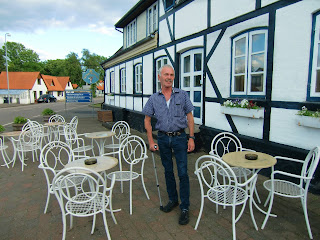





























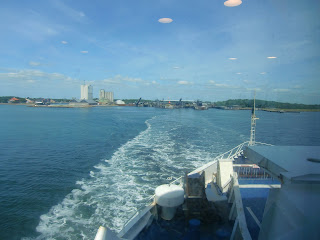




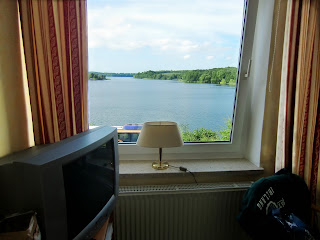










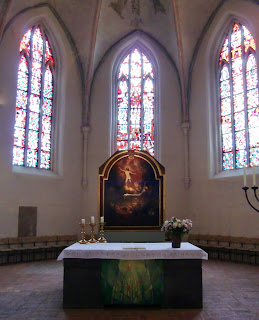







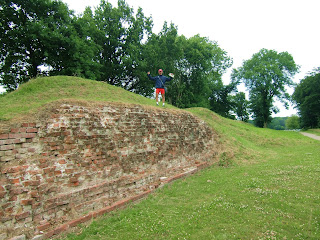


















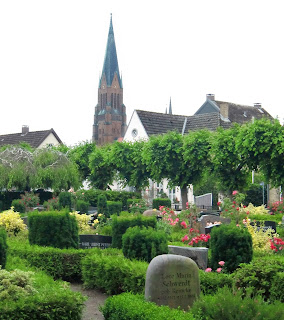





















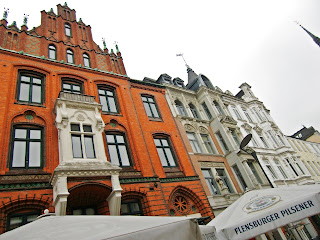
























































No comments:
Post a Comment